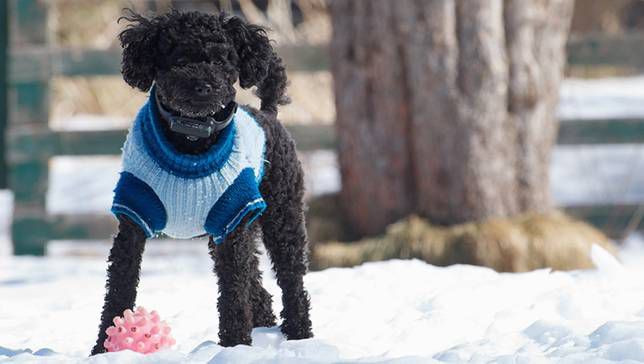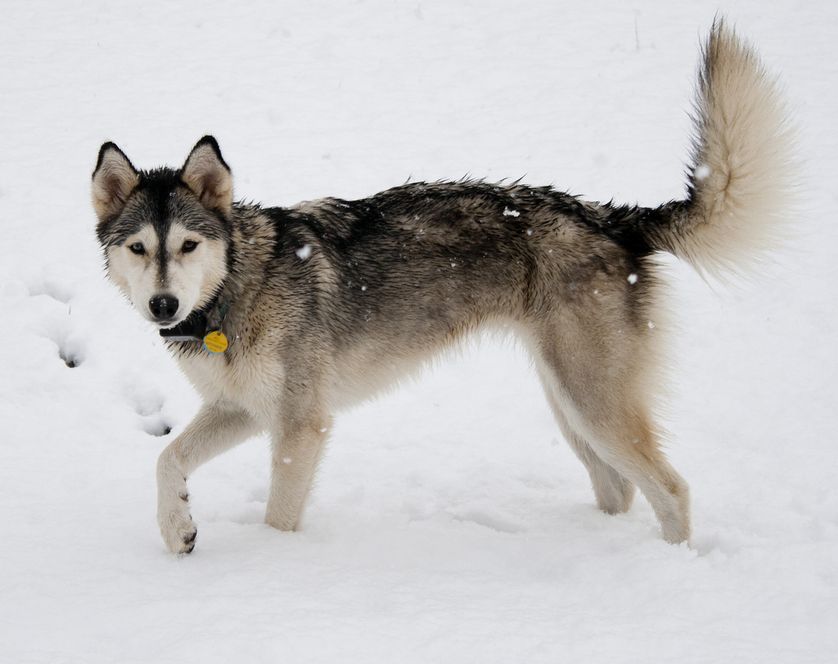A timely article from Mother Nature Network.
A lot of dog owners take care of their dogs in these Winter months by putting on coats or similar when venturing outside. But is it necessary? Laura Moss investigates.
ooOOoo
Does your dog need winter clothes?
LAURA MOSS, December 4, 2018

Many dog owners enjoy dressing their pets in sweaters, coats and scarves, but canine winter gear is often more than a fashion statement.
Just as you need to bundle up when the temperature drops, your dog often does too.
How do you know if your dog needs another layer to stay healthy and warm during winter months?
Doggy, it’s cold outside

Dr. Louise Murray, vice president of the ASPCA Animal Hospital, says your dog will usually provide you with clues that he or she is cold.
“They might shiver, refuse to walk or move, or they may even hold one paw up above the ground to express their dissatisfaction with being outside in the wintry weather,” she said.
A dog’s ability to tolerate cold temperatures depends on several factors, including its health, size, breed and coat thickness.
Smaller dogs, as well as those with shorter fur — such as Chihuahuas and Italian greyhounds — are likely to get cold more quickly.
However, size isn’t always a good indicator of dog’s ability to tolerate cold temperatures. Pit bulls aren’t a small breed, but they have thin coats and can be sensitive to winter weather.
Breeds that come from cold climates and are bred to work in snow and ice, such as Newfoundlands and Siberian huskies, can typically tolerate very cold temperatures.
“If your dog is not a winter-hardy breed, has a thin coat, or has health issues, consider using a canine coat when she heads outdoors,” Murray said. “This will help retain body heat and prevent skin from getting dry and inflamed during winter walks.”
A dog’s routine should also be taken into consideration. If you’re letting your pet outside for a few minutes, he’ll likely be fine without winter gear, but if you’re going for a long walk or spending a while in the outdoors, winter gear may be a necessity.
Finding the right gear

If your dog needs a sweater or coat to stay warm, ensure the garment is a good fit so that it doesn’t drag, get caught on anything or prevent normal movement.
Have your dog try on the items, or measure your pet around the neck, around the largest part of its chest, and from the neck to the waist to choose the best size. The garment should fit snugly but allow freedom of movement. Look for pieces that can be easily taken off and on and that don’t have zippers, buttons or other items that can be chewed or swallowed.
Booties can help protect your dog’s paws from ice and snow, as well as minimize contact with painful salt crystals and poisonous chemicals from antifreeze and ice-melting agents. When it comes to selecting dog booties, look for ones that are insulated, waterproof and provide traction. Just because you have a large dog doesn’t mean he’ll require a large bootie, so measure the width of his paw to find the right fit.
But what about those fancy leggings?

There are also Walkee Paws stretchy dog leggings that cover your dog’s feet and legs with a connector that goes over his back. The leggings keep paws dry and clean in cold, wet conditions without fitting tightly around his ankles.
If your dog isn’t comfortable wearing booties or leggings, you can massage petroleum jelly or a pet-friendly paw wax into his paw pads before going outside.
“After each walk, wash and dry your pet’s feet to remove ice, salt and chemicals, and check for cracks in paw pads or redness between the toes,” Murray said.
Of course, owning a coat or booties won’t do any good if your dog refuses to wear them. If you live in a cold climate, start training your dog to tolerate the items from an early age. Also, reward your dog with a treat or a favorite toy when he wears the items.
Even if your dog is outfitted for winter weather, Murray says you should still limit your pet’s time outdoors and look for signs of frostbite or hypothermia.
Frostbitten areas may appear pale or gray in color and be painful or hard to the touch. Frostbite is most likely to occur on the nose, ears, scrotum or tail.
ooOOoo
Well it seems as though we owe Dr. Louise Murray a vote of thanks for articulating what makes best practice.
Mags has a jaunty orange coat that she is putting to use since we have 10 inches of snow on the ground. Being a Boston Terrier the chilly temps are not her friend.
LikeLike
Ten inches! Wow! Makes us here, Susan, look balmy in contrast!
LikeLiked by 1 person
We found that waxes/creams on Ray’s paws of little help due to salt crystals getting trapped around his pads and causing him discomfort. He gives us the “paw in the air” routine. Ray does not like wearing anything over his paws (of course not because, apart from the sensation, he loses traction!), however, there are many days when he simply has to. He soon forgets he has them on as he gets sidetracked by his scenting instincts.
LikeLike
Colin, that sounds like good advice!
LikeLike
Works for Ray! Sadly we have to allow for not only salt crystals, but all manner of other chemicals that people throw over the sidewalks. Paw covers are a must under those circumstances.
LikeLike
😦 That was an aspect that I hadn’t previously thought of.
LikeLike
It’s scary when you see a blue stain across a slushy sidewalk and have no idea what it is, or whether it is toxic to dogs.
LikeLike
Presumably you have to play it very cautiously?
LikeLike
Our golden rule is “err on the side of caution”. If Ray does not have his boots on, then we detour around such situations rather than risk a problem. Ray’s just far too precious to warrant taking unnecessary risks. 🙂
LikeLike
Precisely what I would have expected you to say!
LikeLike
🙂
LikeLike